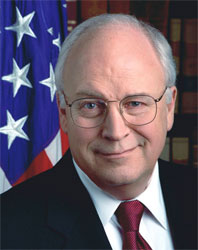Former VP Dick Cheney to Undergo Back Surgery

Former Vice President Dick Cheney, 68, was admitted to George Washington University Hospital today for elective back surgery. The procedure, to be performed by Dr. Anthony Caputy- chairman of the hospital’s neurosurgery department, is being done for pain relief from lumbar spinal stenosis.
The spine is made up of 24 bones called vertebrae, stacked on top of each other as well as the sacrum and coccyx (which are fused vertebrae at the base of the spine). Between the vertebrae are cushions made of cartilage, called the intervertebral discs, which keep the spine flexible and act as shock absorbers. Strong fibrous tissue, called ligaments and bony protrusions of the vertebrae called facets help stabilize the spine. There is an oval shaped space that continues throughout the spine, called the spinal canal, through which the nerves pass from the brain out to the rest of the body.
Spinal stenosis is a frequent cause of back pain as people age. The most common cause is degeneration (osteoarthritis) of the spine. Osteoarthritis is caused by wear and tear on the cartilage which lines the joint surfaces of the vertebrae. Over time, the cartilage can wear away enough that bone rubs against bone, causing back pain and stiffness.The body, in an attempt to repair the damage, will grow new bone in the area, leading to bone spurs, which narrow the spinal canal space.
Another factor that can cause spinal stenosis is related to the intervertebral discs. The discs get worn over time, causing them to become less springy, >brittle, flatter, and to develop small cracks. Sometimes, the jelly-like central portion of the disc seeps out (called disc herniation or rupture) and encroaches on the spinal canal.
Symptoms of spinal stenosis include pain, numbness and tingling, and muscle cramps. The location of these symptoms is dependent on the area of the spine where the stenosis occurs. In lumbar spinal stenosis, in addition to leg pain, cramps and numbness, loss of bowel and bladder control can also occur. Patients may be treated with symptomatic therapy (pain medications, physical therapy) for a prolonged period of time. However, if symptoms are severe or unresponsive to those treatments, surgical intervention may be appropriate.
For more information:
| Resounding Health(tm) Spinal Stenosis |
























0 comments